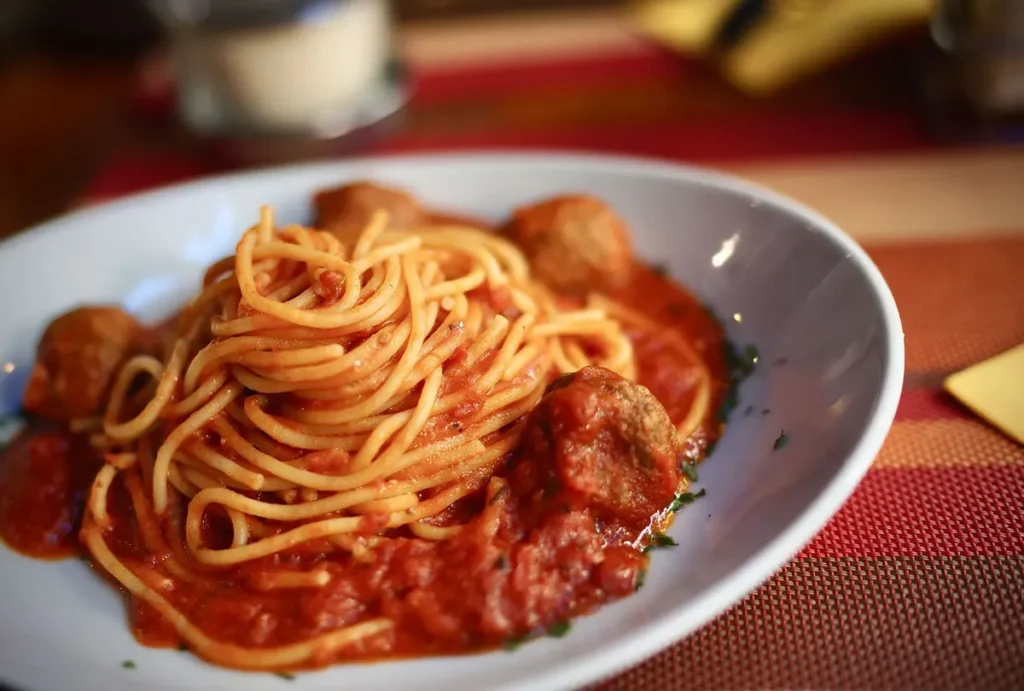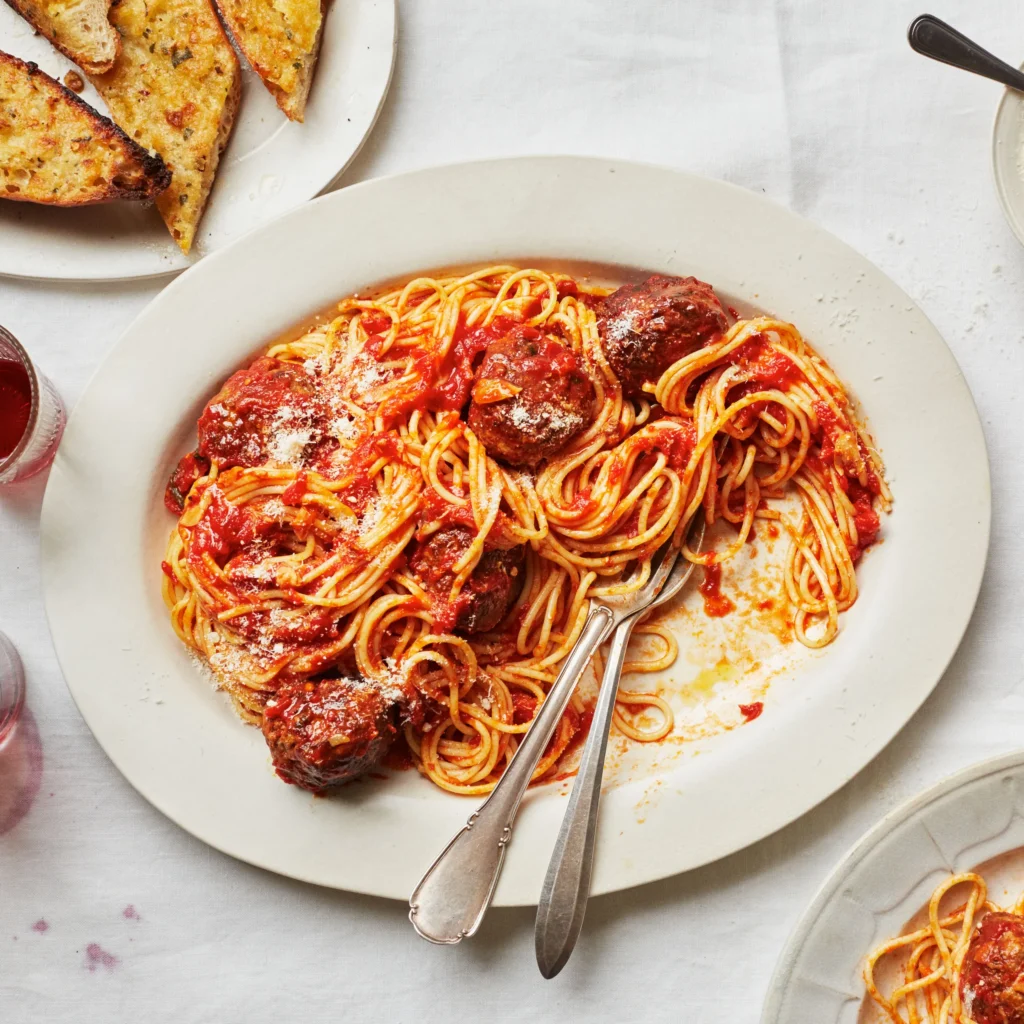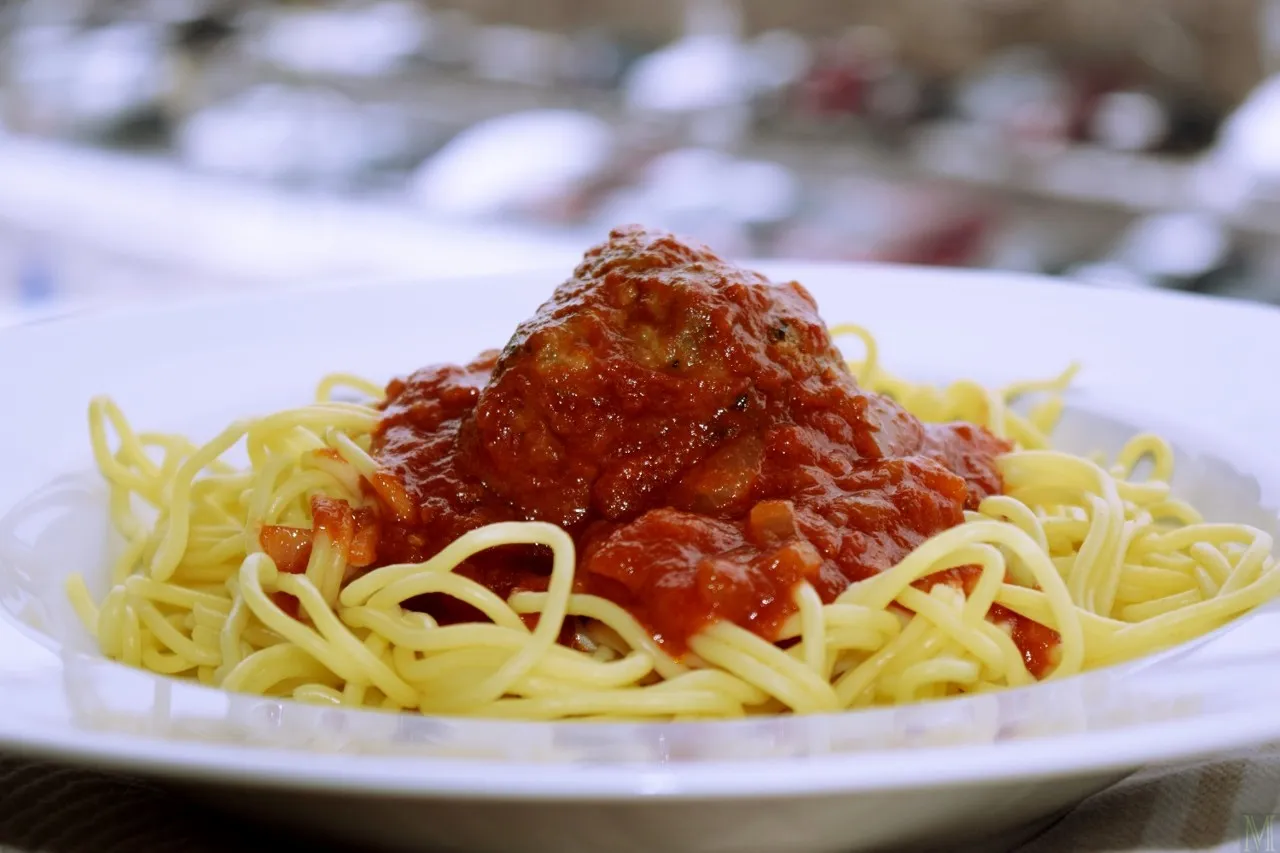The Origins and Evolution of Spaghetti and Meatballs
Spaghetti and meatballs, while often associated with Italian cuisine, is a distinctly Italian-American creation. In Italy, meatballs (polpette) are typically served as a standalone dish or in soups, not paired with pasta. The dish as we know it emerged in the early 20th century among Italian immigrants in the United States, particularly in cities like New York and Chicago. Abundant access to meat, affordable pasta, and canned tomatoes allowed immigrants to adapt traditional recipes into heartier, family-friendly meals. By combining polpette with spaghetti and a robust tomato sauce, they created a dish that was both economical and celebratory.
The dish gained cultural prominence through Italian-American restaurants and pop culture, from Lady and the Tramp’s iconic spaghetti scene to Sunday dinners in The Sopranos. Today, it remains a staple, with recipe variations shared on platforms like Bon Appétit, Serious Eats, and X, reflecting its enduring appeal. In 2025, as home cooking continues to thrive, Homemade Spaghetti and Meatballs embodies nostalgia and comfort, offering a taste of tradition in a fast-paced world.
The Ultimate Homemade Spaghetti and Meatballs Recipe
This recipe for Homemade Spaghetti and Meatballs serves 6–8 and balances authenticity with accessibility, using pantry staples and straightforward techniques. The meatballs are tender and flavorful, the sauce is simmered to perfection, and the pasta is cooked just right. Below are detailed steps, ingredient notes, and pro tips for success.
Ingredients
For the Meatballs:
- Ground Beef: 1 lb (80/20 for optimal flavor and texture)
- Ground Pork: ½ lb (adds richness and tenderness)
- Breadcrumbs: ¾ cup, preferably fresh or panko
- Parmesan Cheese: ½ cup, finely grated (use fresh Parmigiano-Reggiano)
- Egg: 1 large, beaten
- Milk: ¼ cup, to soften breadcrumbs
- Garlic: 2 cloves, minced
- Fresh Parsley: ¼ cup, finely chopped
- Italian Seasoning: 1 teaspoon (or a mix of dried oregano and basil)
- Salt: 1 teaspoon
- Black Pepper: ½ teaspoon
- Red Pepper Flakes: ¼ teaspoon (optional, for a subtle kick)
- Olive Oil: 2 tablespoons, for frying
For the Marinara Sauce:
- Olive Oil: 2 tablespoons
- Onion: 1 medium, finely chopped (about 1 cup)
- Garlic: 3 cloves, minced
- Crushed Tomatoes: 28 oz (one can, preferably San Marzano)
- Tomato Paste: 2 tablespoons, for depth
- Red Wine: ¼ cup (optional, adds complexity)
- Fresh Basil: ¼ cup, torn, plus extra for garnish
- Italian Seasoning: 1 teaspoon
- Sugar: 1 teaspoon (optional, to balance acidity)
- Salt: 1 teaspoon, or to taste
- Black Pepper: ½ teaspoon
For the Pasta:
- Spaghetti: 1 lb (use high-quality brands like De Cecco or Barilla)
- Salt: 1 tablespoon, for pasta water
Equipment
- Large mixing bowl (for meatballs)
- Large skillet or Dutch oven (for sauce and frying)
- Large pot (for pasta)
- Baking sheet (optional, for baking meatballs)
- Tongs or slotted spoon
- Colander
Instructions
- Make the Meatballs: In a large bowl, combine breadcrumbs and milk; let sit for 5 minutes to soften. Add ground beef, ground pork, Parmesan, egg, garlic, parsley, Italian seasoning, salt, pepper, and red pepper flakes (if using). Mix gently with your hands until just combined—overmixing toughens meatballs. Form into 1½-inch balls (about 16–18 meatballs).
- Cook the Meatballs: Heat 2 tablespoons olive oil in a large skillet over medium heat. Working in batches, brown the meatballs on all sides, about 6–8 minutes per batch. They don’t need to be fully cooked, as they’ll finish in the sauce. Transfer to a plate. Alternatively, bake at 400°F on a parchment-lined baking sheet for 15–20 minutes for a hands-off approach.
- Prepare the Marinara Sauce: In the same skillet (or a Dutch oven), heat 2 tablespoons olive oil over medium heat. Add onion and sauté for 4–5 minutes until softened. Add garlic and cook for 30 seconds until fragrant. Stir in tomato paste and cook for 1 minute. Add red wine (if using) and simmer for 2 minutes. Stir in crushed tomatoes, Italian seasoning, sugar (if needed), salt, and pepper. Bring to a simmer, then reduce heat to low and cook for 20–30 minutes, stirring occasionally, until thickened.
- Simmer Meatballs in Sauce: Nestle the browned meatballs into the sauce, spooning some sauce over them. Cover and simmer gently for 15–20 minutes, until meatballs are cooked through (internal temperature of 160°F). Stir in fresh basil just before serving.
- Cook the Pasta: Bring a large pot of salted water to a boil. Add spaghetti and cook according to package instructions (usually 8–10 minutes) until al dente. Reserve ½ cup pasta water, then drain.
- Combine and Serve: Toss the spaghetti with a ladle of marinara sauce to coat. Divide among plates, top with meatballs and additional sauce, and garnish with Parmesan and fresh basil. Use reserved pasta water to loosen the sauce if needed.

Yield and Timing
- Servings: 6–8
- Prep Time: 20 minutes
- Cook Time: 45–50 minutes
- Total Time: ~65–70 minutes
Nutritional Information (Per Serving, Approximate)
- Calories: 620 kcal
- Protein: 32g
- Fat: 28g
- Carbohydrates: 60g
- Sodium: 880mg
Note: Values vary based on portion size and ingredient brands.
Tips for Success
- Don’t Overmix Meatballs: Handle the mixture gently to keep meatballs tender. Wet hands prevent sticking when shaping.
- Use Quality Tomatoes: San Marzano tomatoes offer superior flavor and texture for the sauce.
- Taste and Adjust: Sample the sauce before adding meatballs, adjusting salt, sugar, or seasoning as needed.
- Cook Pasta Al Dente: Slightly undercook spaghetti, as it will absorb sauce when tossed.
- Save Pasta Water: The starchy water helps the sauce cling to the pasta, creating a cohesive dish.
Variations and Serving Ideas
Homemade Spaghetti and Meatballs is endlessly customizable, accommodating dietary needs and creative twists. Here are popular variations and serving suggestions.
Variations
- Vegetarian: Replace meat with a mix of lentils, mushrooms, and breadcrumbs for plant-based meatballs. Use vegetable broth in the sauce.
- Turkey Meatballs: Substitute ground turkey for beef and pork for a leaner option; add extra seasoning to boost flavor.
- Spicy Marinara: Add ½ teaspoon red pepper flakes or a diced jalapeño to the sauce for heat.
- Creamy Tomato Sauce: Stir in ½ cup heavy cream or ricotta for a pink sauce variation.
- Gluten-Free: Use gluten-free spaghetti (like Barilla) and gluten-free breadcrumbs for the meatballs.
- Cheese-Stuffed Meatballs: Tuck a cube of mozzarella inside each meatball for a gooey surprise.
Serving Suggestions
- Classic Style: Serve with garlic bread and a Caesar salad for a traditional Italian-American meal.
- With Veggies: Pair with roasted zucchini, broccoli, or sautéed spinach to add color and nutrition.
- For Gatherings: Present family-style on a large platter, garnished with extra Parmesan and basil, for a festive vibe.
- Wine Pairing: A bold Chianti or Sangiovese complements the sauce’s acidity. For non-alcoholic options, try pomegranate juice or sparkling water with lemon.
- Festive Touch: Add a sprinkle of edible gold flakes or a drizzle of truffle oil for holiday dinners.
Cultural Significance and Modern Appeal
Spaghetti and meatballs is a cornerstone of Italian-American culture, symbolizing family, community, and celebration. It’s a fixture at Sunday suppers, weddings, and holidays, where large platters feed multigenerational gatherings. Its prominence in media—from cookbooks like Lidia Bastianich’s to films like Goodfellas—has made it a global icon. In 2025, the dish resonates with the comfort food renaissance, as home cooks seek recipes that evoke nostalgia while fitting busy lifestyles.
The recipe’s adaptability—whether made with beef, turkey, or plant-based ingredients—makes it inclusive for diverse diets. Its affordability, relying on staples like canned tomatoes and pasta, aligns with budget-conscious cooking trends. Social media platforms like X and Pinterest amplify its popularity, with users sharing tips for perfect meatballs or creative sauce tweaks, fostering a sense of culinary community.
Health Benefits and Dietary Considerations
This dish offers balanced nutrition: beef and pork provide protein (25–30g per serving), iron, and B12, while tomatoes deliver lycopene, an antioxidant linked to heart health. Pasta provides carbohydrates for energy, and Parmesan adds calcium. However, the dish’s fat (20–25g per serving) and sodium (800–900mg) may require moderation for some diets.
To make it healthier:
- Leaner Meat: Use ground turkey or chicken, or a 90/10 beef blend, to reduce fat.
- Lower Sodium: Choose low-sodium tomatoes and limit added salt and Parmesan.
- Whole-Grain Pasta: Opt for whole-wheat spaghetti for added fiber.
- Increase Veggies: Add grated zucchini or carrots to the meatballs or spinach to the sauce for nutrients.
- Dairy-Free: Skip Parmesan or use nutritional yeast for a cheesy flavor.
Pair this meal with a post-dinner walk, as promoted by National Walking Day (April 2, 2025). A 30-minute stroll burns 150–200 calories, aiding digestion and enhancing enjoyment.
Meal Prep and Storage Tips
Homemade Spaghetti and Meatballs is perfect for batch cooking:
- Make Ahead: Prepare meatballs and sauce up to 2 days in advance, storing separately in the fridge. Cook pasta fresh for best texture.
- Storage: Store cooked pasta, meatballs, and sauce in airtight containers in the fridge for up to 4 days. Reheat in a skillet with a splash of water or microwave in 1-minute increments.
- Freezing: Freeze meatballs and sauce (without pasta) in a freezer-safe container for up to 3 months. Thaw overnight in the fridge before reheating. Cook fresh pasta when ready to serve.
- Repurposing: Use leftover meatballs in subs, on pizza, or crumbled into a pasta salad. Extra sauce can top roasted vegetables or polenta.
Community and Social Engagement
This dish is ideal for sharing at potlucks, family gatherings, or virtual cooking clubs. Post your creations on social media with hashtags like #SpaghettiAndMeatballs or #ItalianComfortFood to connect with food lovers. Engage on platforms like Reddit’s r/food or X to share tips, such as soaking breadcrumbs in milk for tender meatballs or simmering sauce low and slow. Host a “Pasta Night” where guests bring their own meatball variations—spicy, cheesy, or veggie—for a fun taste-off.

Conclusion
Homemade Spaghetti and Meatballs is more than a meal—it’s a celebration of heritage, flavor, and connection. Its tender meatballs, vibrant sauce, and twirlable pasta transform simple ingredients into a dish that feels like a hug on a plate. Rooted in Italian-American tradition and beloved worldwide, it’s a testament to the enduring power of comfort food in 2025. Whether you’re cooking for family, friends, or yourself, this recipe delivers joy in every bite.

